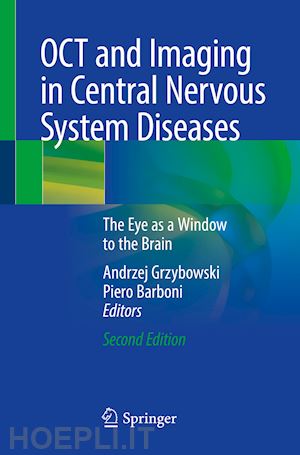
Questo prodotto usufruisce delle SPEDIZIONI GRATIS
selezionando l'opzione Corriere Veloce in fase di ordine.
Pagabile anche con Carta della cultura giovani e del merito, 18App Bonus Cultura e Carta del Docente
The second edition of OCT and Imaging in Central Nervous System Diseases offers updated state-of-the-art advances using optical coherence tomography (OCT) regrading neuronal loss within the retina. Detailed information on the OCT imaging and interpretation is provided for the evaluation of disease progression in numerous neurodegenerative disorders and as a biological marker of neuroaxonal injury. Covering disorders like multiple sclerosis, Parkinson’s disease, Alzheimer’s disease, intracranial hypertension, Friedreich’s ataxia, schizophrenia, hereditary optic neuropathies, glaucoma, and amblyopia, readers will given insights into effects on the retina and the and optic nerve. Individual chapters are also devoted to OCT technique, new OCT technology in neuro-ophthalmology, OCT and pharmacological treatment, and the use of OCT in animal models.
Similar to the first edition, this book is an excellent and richly illustrated reference for diagnosis of many retinaldiseases and monitoring of surgical and medical treatment. OCT allows to study vision from of the retina to the optic tracts. Retinal axons in the retinal nerve fiber layer (RNFL) are non-myelinated until they penetrate the lamina cribrosa. Hence, the RNFL is an ideal structure for visualization of any process of neurodegeneration, neuroprotection, or regeneration. By documenting the ability of OCT to provide key information on CNS diseases, this book illustrates convincingly that the eye is indeed the “window to the brain”.
Introduction: Retina Imaging – Past and Present.- OCT Technique – Past, Present and Future.- Optical Coherence Tomography and Optic Nerve Edema.- OCT and Compressive Optic Neuropathy.- Optical Coherence Tomography (OCT) and Multiple Sclerosis (MS).- OCT and Parkinson’s Disease.- Optical Coherence Tomography in Alzheimer’s Disease.- Friedreich’s Ataxia and More: Optical Coherence Tomography Findings in Rare Neurological Syndromes.- Other Neurological Disorders: Migraine, Neurosarcoidosis, Schizophrenia, Obstructive Sleep Apnea-Hypopnea Syndrome (OSAHS).- Hereditary Optic Neuropathies.- Trans Neuronal Retrograde Degeneration to OCT in Central Nervous System Diseases.- OCT in Toxic and Nutritional Optic Neuropathies.- Animal Models in Neuro Ophthalmology.- Optical Coherence Tomography (OCT) in Glaucoma.- OCT in Amblyopia.- Conclusion: The Exciting Future of OCT Imaging of Retina.
Andrzej Grzybowski, M.D., Ph.D., MBA, is a Professor of Ophthalmology and Chair of Department of Ophthalmology, University of Warmia and Mazury, Olsztyn, Poland; Head of Institute for Research in Ophthalmology, Foundation for Ophthalmology Development, Poznan, Poland.
He is active in international scientific societies including Euretina (Co-opted Board member 2016-2018), Retina Society, AAO (International Fellow; member of the Global ONE Advisory Board and Museum of Vision’s Program Committee), EVER (Board member and chair of cataract section), ESCRS (curator of ESCRS Archive), and ISRS (member of the ISRS International Council), ISBCS, International Council of Ophthalmology (programme coordinator for WCO in 2011-2018), and Cogan Society. He became lifelong member (chair LIV) of the European Academy of Ophthalmology and its Treasurer. He has been active contributor to major ophthalmic conferences worldwide, including AAO (Achievement Award 2017, International Scholar Award 2018), APAO (International Coordinator 2017, Achievement Award 2018), WCO (Programme Coordinator 2010-2018), Euretina, ESCRS, EVER, ISOPT, etc.
He has been active editor, editor in chief and author of more than 450 peer-reviewed international publications (total IF higher than 1000), and over 50 book’s chapters; reviewer for more than 20 journals. He is a member of editorial boards of American Journal of Ophthalmology (IF 4.795), Acta Ophthalmologica (IF 3.157), PLOS One (IF 2.806), Graefe’s Archive for Clinical and Experimental Ophthalmology (IF 2,349), Translational Vision Science & Technology (TVST), (IF 2.221), BMC Ophthalmology (IF 1.586), Clinics in Dermatology (IF 2.253), Journal of Clinical Medicine (IF 5.8); Frontiers in Neurology (IF 3.5), Neuro-Ophthalmology (IF 0.2), Saudi Journal of Ophthalmology, Asia Pacific Academy of Ophthalmology Journal, and editor in chief of Archives of History and Philosophy of Medicine and Historia Ophthalmologica Internationalis.
Piero Barboni, MD, graduated in Medicine and Surgery from the University of Bologna, Italy, in 1986 and went on to complete his Specialization in Ophthalmology at the same university in 1990. After spending almost two decades in private practice, he was appointed Professor of Neuro-ophthalmology in the Department of Neurological Science, Bologna University. Since 2012 Dr. Barboni has been a Consultant Ophthalmologist at the Scientific Institute San Raffaele, University of Milan. His memberships include the Association for Research in Vision and Ophthalmology (ARVO) and the North American Neuro-Ophthalmology Society (NANOS). Dr. Barboni has been sub-investigator in many clinical trials on good clinical practice in multiple sclerosis and is a participant in an international research project on Leber’s hereditary optic neuropathy. He is the author of more than 70 articles in peer-reviewed journals.











Il sito utilizza cookie ed altri strumenti di tracciamento che raccolgono informazioni dal dispositivo dell’utente. Oltre ai cookie tecnici ed analitici aggregati, strettamente necessari per il funzionamento di questo sito web, previo consenso dell’utente possono essere installati cookie di profilazione e marketing e cookie dei social media. Cliccando su “Accetto tutti i cookie” saranno attivate tutte le categorie di cookie. Per accettare solo deterninate categorie di cookie, cliccare invece su “Impostazioni cookie”. Chiudendo il banner o continuando a navigare saranno installati solo cookie tecnici. Per maggiori dettagli, consultare la Cookie Policy.